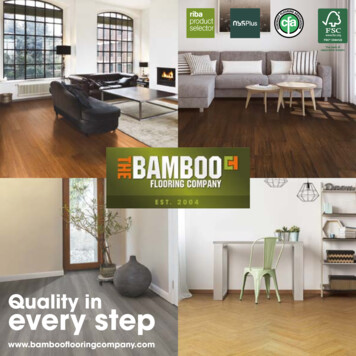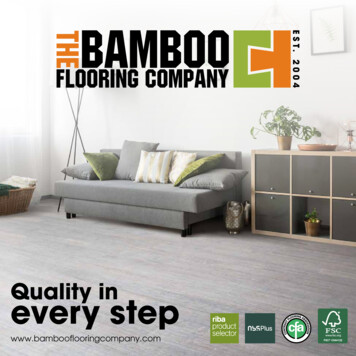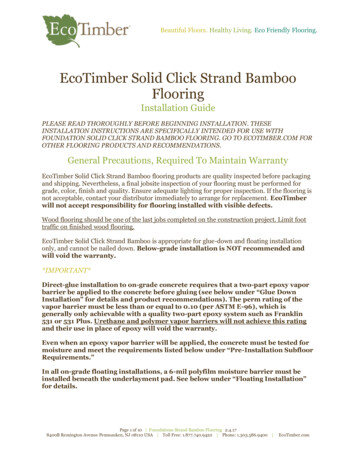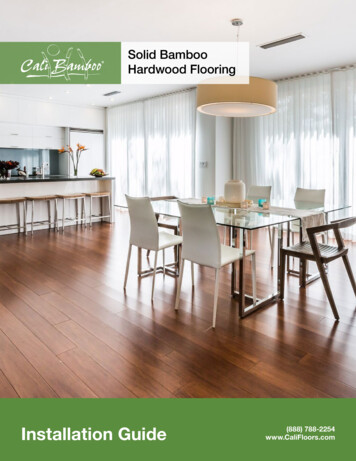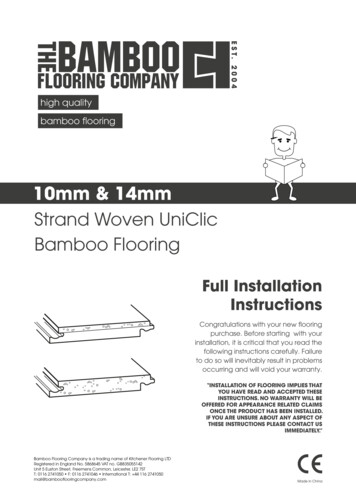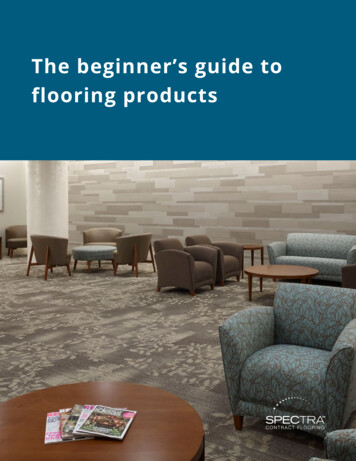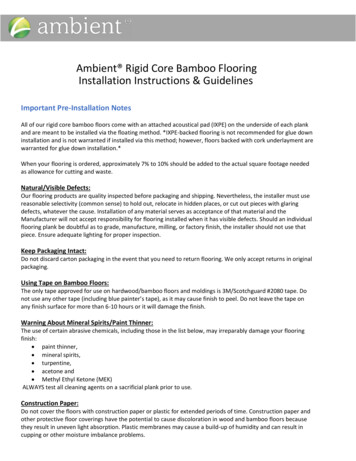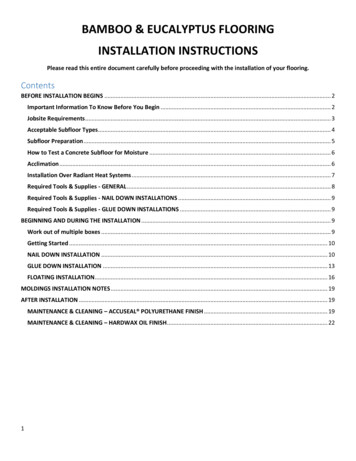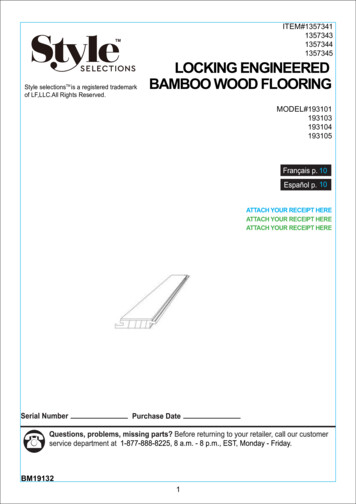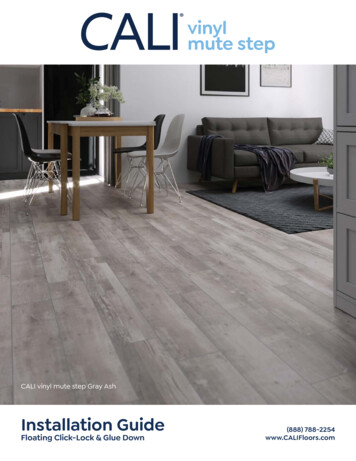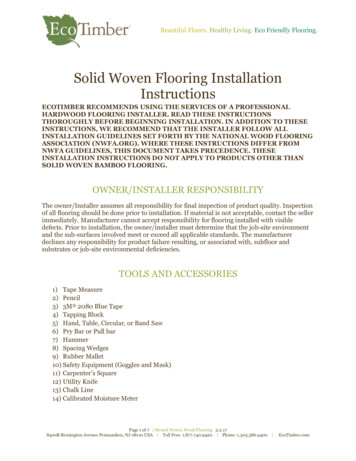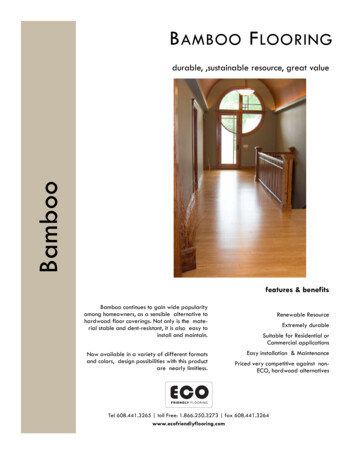
Transcription
B AMBOO F LOORINGBamboodurable, ,sustainable resource, great valuefeatures & benefitsBamboo continues to gain wide popularityamong homeowners, as a sensible alternative tohardwood floor coverings. Not only is the material stable and dent-resistant, it is also easy toinstall and maintain.Now available in a variety of different formatsand colors, design possibilities with this productare nearly limitless.Renewable ResourceExtremely durableSuitable for Residential orCommercial applicationsEasy installation & MaintenancePriced very competitive against nonECO, hardwood alternativesTel 608.441.3265 toll Free: 1.866.250.3273 fax 608.441.3264www.ecofriendlyflooring.com
Bamboo FlooringNatural FibrestrandCarbonized FibrestrandNatural VerticalCarbonized VerticalNatural HorizontalCarbonized HorizontalWalnut HandscrapedChestnut HandscrapedCarbonized Fibrestrand Woven Bamboo Flooring3-3/4” x 9/16” x 6’ tongue-groove prefinished planksManufacturing treatements:Natural borate solution and hydrogen peroxide to eliminate pests and mildew.ASTM Test Results: (please note, test results vary for each variety of bamboo, please check with us for the resultsfor your specific model choice)Hardness: ASTM D 1037, Janka Ball: 2642Dimensional Stability: ASTM D 1037: Dimensional change coefficients:0.04 parallel / 0.57 perpendicular / 0.6 thickness.Flammability: ASTM E 648: Class I Interior Floor Finish rating per NFPA 101.Smoke Density: ASTM E 622: Maximum 344 in flaming mode; 191 in non-flaming mode.Compressive Strength: ASTM D 3501: Minimum 14,080 psi (96 MPa).Abrasion Resistance: ASTM D 4060, CS-17 Taber abrasive wheels: Final wear-through: Minimum 16,000 cycles.Moisture Content: ASTM D 4442, Oven Dry Method: 7.8 percent, average.Formaldehyde Emissions: ASTM E 1333: 0.01 ppm.Finish: KLUMPP brand. Durable 6-Coat Factory Water-based primer, an anti-abrasive sealer with aluminum oxide, UV Sealer,and three topcoats of scratch resistant polyurethane -- solvent-free and non-offgassing.Tel 608.441.3265 toll Free: 1.866.250.3273 fax 608.441.3264
Installation & MaintenanceMAINTENANCEBamboo is a natural product that will expand and contract with humidity changes. Maintenance of the household humidity at about40-50% year round will minimize these changes.Use damp mop and vinegar water (10% vinegar: 90% water) for cleaning.You may use products like a Tibet Almond Stick or OLD English Scratch cover to wipe out surface scuffs from the floor.Vacuum sand regularly.Extreme sunlight over a long period of time will fade any natural product. Use window coverings/shades to minimize that effect.Be sure to use felt pads under feet of furniture for maximum protection against scratching.If water is spilled on the floor, be sure to wipe up as soon as possible to prevent warping of the floor. Standing water on the floorover a period of 10 hours or more will damage your floor.Floor can be refinished using standard wood floor refinishing methods.INSTALLATIONImportant : Carefully inspect all material before installation. Any material installed with obvious defects will not be warrantedSolid Bamboo Installation InstructionsGeneral conditions: In area to be installed, temperature and humidity must be brought to normal usage levels at least 72 hoursbefore installation and maintained at those levels after installation. Flooring should be allowed to acclimatize on site at least 72hours before installation. Be sure to use your moisture meter to check moisture levels in both the sub-floor and the bambooflooring .Applications: May be nailed or glued down over wood sub-floors or glued directly to concrete sub-floors on, above, or belowgrade.Sub-floor: Surfaces must be clean, dry, smooth and free of dirt, wax, oil, paint, curing agents and other contaminants that wouldinterfere with adhesive bond. Old resilient floors can be installed over provided above conditions apply. Wood sub-floors must besanded level prior to new installation. Concrete sub-floors must have all cracks and holes filled with a cementitious patchingmaterial (Ardex or equal). Concrete sub-floors must be tested for moisture and not exceed three pounds per 1,000 square feetusing the calcium chloride test.Work out of multiple (2-3) boxes. Bamboo is a natural product and has natural color variations. Bamboo flooring is separatedby shade at the factory. There are no standards for this so the shade differences between cartons may be noticeable. Mixingcartons creates a natural, random shade effect.Nail Down: Planks shall be started square with the room and parallel to its longest dimension by positioning with a chalk line,leaving 1/4" expansion space from base plate or wall. Ensure starter rows are firmly in place by wedging or face nailing. Onceinitial rows are secure, second and further courses shall be blind nailed directly above tongue at a 45-50 degree angle to theface. Fasteners shall be spaced at 10-12 inch intervals with a minimum of 2 fasteners per piece. NOTE: There will not be a guarantee for Bamboo flooring installed over or onto particleboard. (OSB is the exception)Note: In extremely dry climates, care should be taken to avoid shrinkage by allowing flooring to acclimate under actual use conditions. Remove the planks from the box and expose to local conditions for several days.Glue Down Installation: Use a moisture barrier wood flooring adhesive like "Bostik's Best" or Franklin.s 811 Plus. Follow the adhesive manufacturer’s guidelines for safe use, storage and handling.Wear gloves and long sleeves. Spread with a notched trowel as recommended by the adhesive manufacturer. Planks shall bestarted square with the room and parallel to its longest dimension by positioning with a chalk line, leaving 1/4" expansion spaceTel 608.441.3265 toll Free: 1.866.250.3273 fax 608.441.3264
Installation & Maintenancefrom base plate or wall. Ensure starter rows are firmly in place by wedging or face nailing. Once initial rows are secure, use adhesive in a Wet-Lay method of installation as follows: Apply adhesive to substrate with suitable trowel. Immediately place flooringonto "wet" adhesive. Spread no more adhesives than can be worked with in a forty-minute period (100 to 200 sq. ft.). Cleanany adhesive that comes in contact with the face of the plank immediately.Moisture: While bamboo flooring is much more stable than most woods, it is still subject to damage when in direct contactwith a constantly wet slab. The bamboo must be isolated from this type of slab by use of a reverse vinyl or sleeper subfloor. Urethane adhesive will usually fail when vapor pressure exceeds 3 pounds per 1000 sq. ft. in 24 hours. Bambooflooring cannot be glued down under those conditions.Floating Floor Installation:Sub Floor: Concrete subfloors must be tested for moisture and a vapor retarder such as 6 mil polyethylene film on the subfloorshould be applied overlapping 8" and taping the seams. For all floors, cover floor areas with 1/8" closed cell poly foam (2 lbs.per cubic foot), rolled out and taped at seams. We recommend using the Calcium Chloride Test Method. Flooring must not beinstalled if vapor pressure exceeds 3 lbs. per 1000 square feet in 24 hours. Concrete should be checked for flatness prior to installation and low spots and voids filled to a minimum of 3/16" in 8 foot radius, and high spots ground to surface. Surface must besmooth and free of debris, oils, grease and solvents. Small cracks and chips in concrete, nail holes or hammer dents in wood andsmall gaps between underlayment sheets are not a problem with the floating installation method.Tools needed for installation: Hammer (1 lb.), tape measure and pencil, scribing block, carpenter square, drill, flat bar, ½"wedges, saw.Floating Floor Process: Cut all door jams to the proper height to accommodate the new floor. Place a board next to the jamb.Using it as a guide for the saw can help accomplish this. Recommended expansion is 1/12" for each 36" of installed product. A24' wide room would require about ¾" expansion on all sides. With a circular saw (carbide blade), cut the flooring tosize. Set a distance of 0.5 inches around the wall by using wedge spacers which are later removed. Using a chalk line, make surethe rows are perfectly straight. No fastening to the subfloor is required. Use the cutoff piece to start the next row, reducing thewaste factor. Stagger the end joint at least 12 inches. Boards along the first row must be straight. Walls often are not straight,therefore, it is important to square the first board. Lay the first board with the groove facing the wall and place wedges the thickness of the desired spacing at each end of the board to establish the correct expansion. Join additional boards along the length ofthe room. Continue laying boards in the first row by tapping the end joints and pull the last board into place with a pinch barBegin the second row using the cutoff from the first row as the starter board for this row. This assures staggered end joints. Use atapping block to put the boards together (tap gently until a snug fit is achieved). Continue this process until all but the last board isfinished. Never strike the boards directly in order to engage the tongue and groove. Always used an approved tapping block andhold it tightly pressed to the tongue of the flooring. If not, damage to the top layer could result.If the final board requires cutting along the length to complete the installation, place the board to be cut on top of the next to thelast row and place another board (tongue touching the wall) on top of the board to be cut as a straight edge and mark board tobe cut. Cut the marked board on the table saw and fit it into the open space. Continue until all boards in the last row fit together.Radiant Floor Heat Floating Installations (only for Radiant Heat Applications):Heating System: A radiant floor should not produce temperatures over 85 degrees Fahrenheit. Prior to installation, the heat system must be operated at normal living temperature for a minimum of seven (7) days. One or two days before flooring is laid,switch off heating unit. (At the time of installation subfloor must be 64 degrees to 68 degrees Fahrenheit.) Room temperatureshould not vary more than 15 degrees season to season. 35% to 55% humidity required in home of radiant floor in all seasons.Subfloor: Heating pipes must be covered with 1-1/4" of concrete or a minimum of 1/8" below bottom of plywood subfloor. Concrete subfloor must have a moisture content below 3% by weight. Heat transfer plates or insulation must be in place under pipesunder plywood subfloors.Tel 608.441.3265 toll Free: 1.866.250.3273 fax 608.441.3264
Installation & MaintenanceAccording to the National Wood Flooring Association (NWFA), it is recommended that an outside thermostat be installed to minimize the effect that rapid changes in temperature will have on the floor. Radiant systems work most effectively with any woodflooring if the heating process is gradual, based on small, incremental increases in relation to the outside temperature. Alsorecommended is a 6-8 mil polyethylene vapor barrier installation over slab radiant heat systems. Tape all seams to be sure barrier is tight.When the slab has cured, turn the heat on, regardless of season, and leave it on for at least 5-6 days before installation ofthe flooring. The radiant heat system should remain in operation after installation.WARRANTYRead the following instructions before starting the installation. Warranty does not cover materials with visible defects once they areinstalled. Place the packages in the room of installation 48 hours prior to installation to acclimate to room temperature. Prior toinstallation, the installer should inspect all material and determine if it matches the work order. Check the quantity and productitem number for accuracy. Any defects should be reported to Eco-Friendly Flooring immediately. The cost of labor will not be paidwhen a floor with visible defects has been installed. Humidity range for the job site should be between 35% and 55% and thetemperature setting to within 15 degree Fahrenheit of normal living conditions.Because bamboo is a natural fiber, variations in color naturally occur. Eco-Friendly Flooring is manufactured in accordance withU.S. industry standards, which permit a defect tolerance not to exceed 5%. Eco-Friendly Flooring warranty is in effect if productsare installed using Eco-Friendly Flooring’s Installation Instructions, recommended adhesive for glue down floors and floor care recommendations and if proper humidity conditions are maintained within the home. Each bundle should be inspected for differencesin color and staggered throughout the floor. Warranty does not cover variations in color nor variations between samples and theinstalled floor.It is the responsibility of the installer/owner to determine if the job site subfloor and job site conditions are environmentally acceptable for the installation of Eco-Friendly Flooring Bamboo. We decline any responsibility for failure resulting from or connectedwith subfloor, sub-surface, or job site damage, or deficiencies after flooring has been installed.Eco-Friendly Flooring.s bamboo can be installed at, or above grade and can be applied over radiant floor heating systems, onconcrete, existing wood floors, plywood, underlayment, particle or OSB board, resilient tile, existing sheet goods (with the exception of loose laid or perimeter adhesive sheet goods), terrazzo, or ceramic tiles as long as the subfloors are structurally sound,clean, level and dry. It can be floated or glued down.Tel 608.441.3265 toll Free: 1.866.250.3273 fax 608.441.3264
Moisture: While bamboo flooring is much more stable than most woods, it is still subject to damage when in direct contact with a constantly wet slab. The bamboo must be isolated from this type of slab by use of a reverse vinyl or sleeper sub floor. Urethane adhesive will usually fail when vapor pressure exceeds 3 pounds per 1000 sq. ft. in 24 .
